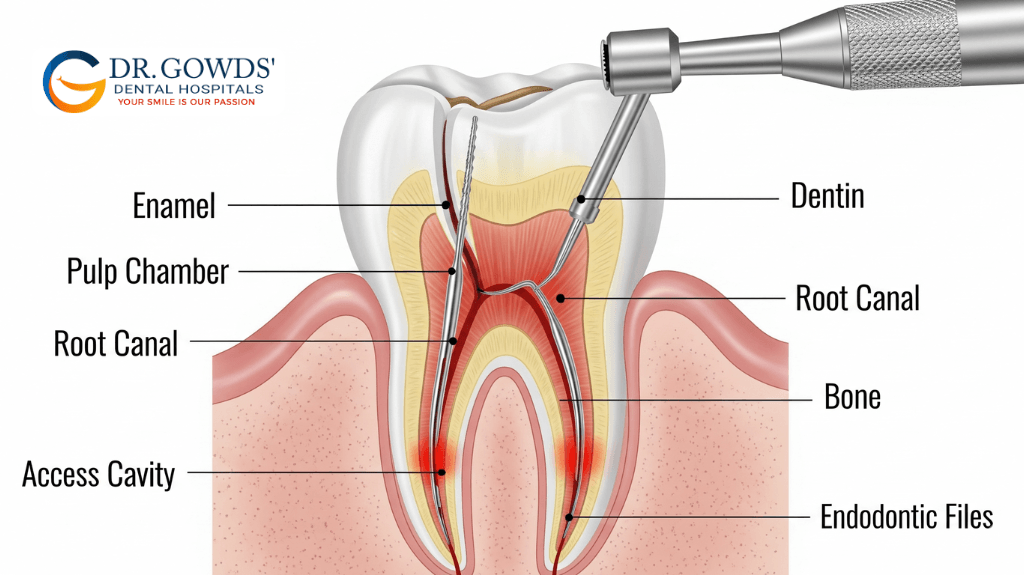What is Root Canal Treatment (RCT)?
Root Canal Treatment, or RCT, is a dental procedure that helps save a tooth that is badly decayed or infected.
Inside every tooth is a soft tissue called the pulp, which contains nerves and blood vessels. When this pulp becomes infected due to decay, cracks, or injury, it can cause severe pain or swelling.
RCT works by:
- Removing the infected pulp
- Cleaning and shaping the inside of the tooth
- Filling and sealing it to prevent future problems
With modern technology, RCT is now much quicker, more comfortable, and often completed in just one visit — helping you keep your natural smile for life.
Then vs Now – Root Canal Treatment
Old Method
- Multiple long appointments
- More discomfort during and after treatment
- Limited visibility inside the tooth
- Slower, less precise tools
Modern Method
- Often completed in a single visit
- Minimal discomfort with advanced anesthesia and tools
- High-precision imaging for accurate diagnosis
- Faster, safer, and more predictable results
Key Advances Shaping the Future of Root Canal Treatment
Modern dentistry has transformed root canal treatment from a feared procedure into a precise, comfortable, and highly successful solution.
Digital Imaging and 3D CBCT
Cone Beam Computed Tomography (CBCT) provides a clear, three-dimensional view of the tooth and surrounding tissues.
- Detects hidden canals
- Improves treatment planning
- Reduces complications
Dental Loupes and Operating Microscopes
High-quality magnification tools — from loupes to microscopes with up to 25× zoom — enable dentists to locate even the tiniest calcified canals for unmatched precision.
Rotary and Reciprocating NiTi Instruments
Nickel-Titanium (NiTi) files are:
- Flexible yet durable
- Faster in shaping canals
- Designed to preserve more tooth structure
Advanced Irrigation Systems
From ultrasonic to multisonic technology, these systems push cleaning solutions into every microscopic space, ensuring deep cleaning and bacteria removal.
Bioceramic Sealers
- Biocompatible and safe for tissues
- Chemically bond to dentin
- Maintain a long-lasting seal and promote healing
Single-Visit Endodontics
With these advances, many root canals can now be completed in one appointment — reducing patient stress, travel time, and recovery periods.
The Bottom Line
Modern root canal treatment is faster, more comfortable, and more predictable than ever before.
If you have been avoiding RCT because of old fears, it is time to embrace the new reality: a gentle, precise treatment that can save your natural smile — often in just one visit.
📞 Book Your Appointment | 🌐 Visit drgowddental.com
FAQs About Root Canal Treatment
What is Root Canal Treatment (RCT)?
Root Canal Treatment, or RCT, is a dental procedure designed to save a tooth that is badly decayed or infected. It involves removing the infected pulp, cleaning the tooth, and sealing it to prevent further infection.
Why is the pulp inside the tooth important?
The pulp contains nerves and blood vessels that keep the tooth alive. When infected due to decay, cracks, or injury, it can cause severe pain or swelling, making RCT necessary.
How was root canal treatment done in the past?
Older methods involved multiple long appointments, limited visibility inside the tooth, slower tools, and greater discomfort during and after the procedure.
How has modern root canal treatment improved?
Modern techniques allow many treatments to be completed in a single visit, with minimal discomfort, advanced anesthesia, high-precision imaging, and faster, safer tools.
What role does CBCT imaging play in root canal treatment?
Cone Beam Computed Tomography (CBCT) provides a clear 3D view of the tooth and surrounding tissues, helping detect hidden canals, improve planning, and reduce complications.
Why are dental loupes and operating microscopes important in RCT?
Magnification tools such as dental loupes and microscopes with up to 25× zoom help dentists locate tiny or calcified canals for precise and effective treatment.
What are rotary and reciprocating NiTi instruments?
Nickel-Titanium (NiTi) instruments are flexible and durable tools that shape canals faster and more safely while preserving more of the tooth structure.
How do advanced irrigation systems improve RCT success?
Modern ultrasonic and multisonic irrigation systems ensure cleaning solutions penetrate microscopic spaces, removing bacteria and reducing reinfection risks.
What are bioceramic sealers used in root canals?
Bioceramic sealers are biocompatible materials that bond chemically to dentin, create a durable seal, and promote better long-term healing.
Can root canal treatment be done in one visit?
Yes, with the latest technology, many root canal treatments can now be completed in a single visit, reducing patient stress, travel time, and recovery periods.
